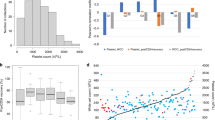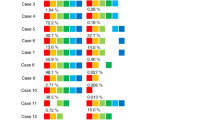Abstract
We have anecdotally noted that serum LDH values rise after the infusion of autologous peripheral blood progenitor cells (PBPCs), presumably the result of cellular lysis. To further study this issue, we retrospectively reviewed 203 consecutive patients undergoing autologous PBPC transplant from August 1996 to December 1997. 194 patients were evaluable, having documented LDH values on day −1 to day +5 post-transplant. All patients received cytokine mobilization for PBPC collection, and 99% received a chemotherapy-only preparative regimen. 99% of patients had a rise in serum LDH after PBPC infusion. 76% had a normal LDH prior to PBPC infusion that became abnormally high after infusion; 22% began with an abnormally high value that became higher with the infusion of PBPCs. The LDH rose at least 50% in 91% of patients. 92% of the patients had their peak LDH value occur on day +1 post-transplant. The total dose of CD34+cells infused negatively correlated with peak percentage change of LDH (P = 0.0007). This result was initially perplexing, as we believed that a higher number of infused cells would correlate with a higher LDH value as a result of in vivo cellular lysis. However, the total number of CD34+ cells also negatively correlated with the number of phereses required to collect our threshold of 2.0 × 106CD34+ cells/kg (P = 0.0001). After adjusting for CD34+cell dose, we found that the number of phereses correlated highly with a peak percentage of change of LDH (P = 0.001). We conclude that the serum LDH increases universally after autologous PBPC infusion, peaking on day +1. We believe that this rise in serum LDH is a result of cell lysis that occurs ex vivo, and correlates with the number of pheresis procedures required to collect an adequate number of CD34+ cells. This may be a result of increasing red blood cell contamination with more phereses, and resultant RBC hemolysis.
This is a preview of subscription content, access via your institution
Access options
Subscribe to this journal
Receive 12 print issues and online access
$259.00 per year
only $21.58 per issue
Buy this article
- Purchase on SpringerLink
- Instant access to full article PDF
Prices may be subject to local taxes which are calculated during checkout
Similar content being viewed by others
Author information
Authors and Affiliations
Rights and permissions
About this article
Cite this article
Bolwell, B., Pohlman, B., Kalaycio, M. et al. LDH elevation after autologous stem cell transplantation. Bone Marrow Transplant 24, 53–55 (1999). https://doi.org/10.1038/sj.bmt.1701812
Received:
Accepted:
Published:
Issue Date:
DOI: https://doi.org/10.1038/sj.bmt.1701812



